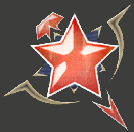Soviet Units
Armoured Vehicles
The Red Army operates the "Deep Operations" doctrine of mechanised warfare. This calls for huge mobile formations which can strike through enemy lines using overwhelming numbers. Combined arms from air and mobile land forces put overwhelming pressure the enemy rear areas causing a catastrphoic collapse in their ability to fight. Such strategies require a large amount of intelligence and skill in the officer corps and in up to date and potent weapons. Sadly the Red Army lacks both. However with vast production capacity and huge manpower, the resurgence of the Red Army is only a matter of time. Once the technological edge is regained, then huge sweeping attacks featuring hundereds of Tanks are an inevitability.
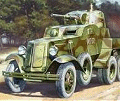 BA-10
BA-10
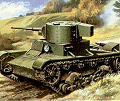 T-26
T-26
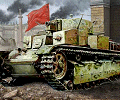 T-28
T-28
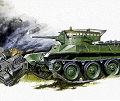 BT-7
BT-7
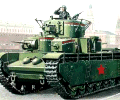 T-35
T-35
 KV-1 (early)
KV-1 (early)
 KV-1 (late)
KV-1 (late)
 KV-2
KV-2
 KV-85
KV-85
 IS-2
IS-2
 IS-3
IS-3
 ISU-152
ISU-152
 T-34 (early)
T-34 (early)
 T-34 (inter)
T-34 (inter)
 T-34 (late)
T-34 (late)
 T-34/85mm
T-34/85mm
 T-44
T-44
 OT-34
OT-34
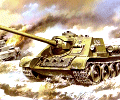 SU-100
SU-100
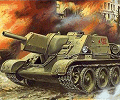 SU-122
SU-122
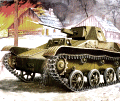 T-60
T-60
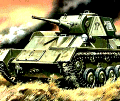 T-70
T-70
 SU-76
SU-76
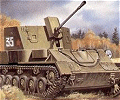 ZSU-37
ZSU-37
 Back
Back
BA-10
Tech:
StartCost:
150Built Time:
12 secsBuilt At:
Early FactoryHealth:
90Armour:
LightFirepower:
108 (light penetration)Rate of Fire:
6 secsRange:
360Speed:
38Armoured cars have been used successfully for years and General Zhukov used them to great success against the Japanese in Mongolia. Their low cost and flexibility allows for fast attacks and raids into the enemy rear. Their 45mm gun allows them to take on isolated enemy armour to some success, assuming they attack with adequate numbers and have infanty support.
 Back
Back
T-26
Tech:
StartCost:
300Built Time:
18 secsBuilt At:
Early FactoryHealth:
103Armour:
Light-MediumFirepower:
103 (light penetration)Rate of Fire:
6 secsRange:
314Speed:
22Passengers:
3 ConscriptsThe T-26 is based on the ubiquitous Vickers 6 ton tank from the end of the Great War. While the design has
been itterated since then, the tank is essentially obsolete. The Red Army is moving to replace these tanks
but they will make up the bulk of their tank forces in the mean time. Of course, it is better to have an
obsolete tank than no tank at all. Used in large numbers and protected by infantry, these tanks can still
be effective in defense of the motherland.
The Red Army makes use of 'Tank Desant' which calls for infantry to ride into battle on the sides of tanks,
before dismounting and covering the tank assault directly.
 Back
Back
T-28
Tech:
StartCost:
950Built Time:
50 secsBuilt At:
Early FactoryHealth:
227Armour:
Light-MediumFirepower:
143 (medium penetration)Rate of Fire:
6 secsRange:
314Speed:
20The T-28 uses an anachronistic multi-turret design, but in many ways is a cutting edge tank. It has a balance of moderate armour, speed and fire power that will prove so effective in later designs such as the T-34. In combat it has much better fire power and protection than its lighter counterparts and so can perform much more successfully. However it is much rarer than the ubiquitous T-26 and so a combination of both tanks is probably the best approach.
 Back
Back
BT-7
Tech:
StavkaCost:
400Built Time:
26 secsBuilt At:
Early FactoryHealth:
114Armour:
Light-MediumFirepower:
103 (light penetration)Rate of Fire:
6 secsRange:
314Speed:
57The BT-7 is a fast-tank designed for a cavalry role. It has simmilar protection and firepower to the T-26 but much greater speed. This allows it to make lighting raids on enemy positions, or withdraw from unfavourable fights. The BT-7s should be a used as a flexible raiding force and not used to take on enemy armour. Their HE rounds can easily clear enemy garrisons or destroy light trucks and other soft assets.
 Back
Back
T-35
Tech:
Level 1Cost:
2150Built Time:
60 secsBuilt At:
Early FactoryHealth:
216Armour:
HeavyFirepower:
143 (medium penetration)Rate of Fire:
6 secsRange:
314Speed:
20The T-35 is another multi-turret design but far less imaginative than the T-28. The T-35 is essentailly a minature battleship on treads. It has thin armour, but its pure bulk makes it a formiddable opponent. With a huge 11 man crew, 4 turrets and over 45 tons of bulk, the T-35 is a huge vehicle. Totally obsolete, they are being pressed into emergency divisions to be hurled at the enemy. In such a role they are actually rather effective, absorbing large amounts of enemy fire and relieving the pressure from their comrades.
 Back
Back
KV-1 (early)
Tech:
Level 2Cost:
3000Built Time:
60 secsBuilt At:
Early FactoryHealth:
384Armour:
HeavyFirepower:
155 (medium penetration)Rate of Fire:
10 secsRange:
450Speed:
20The Kliment Voroshilov tanks are named for the defence commissar of the same name. They are designed to be impervious to any enemy tanks while in return carrying enough firepower to take take on any enemy armour. They are huge and expensive but extremely tough. Essentially they can play a more refined version of the T-35's role, absorbing enemy fire and relieving pressure from their comrades in lighter vehicles. Sadly, their huge expense and production time makes them unsuitable to form the mainstay of any force.
 Back
Back
KV-1 (late)
Tech:
Level 3Cost:
1200Built Time:
12 secsBuilt At:
Tchelyabisk (Tankograd) WorksHealth:
481Armour:
HeavyFirepower:
173 (medium penetration)Rate of Fire:
10 secsRange:
450Speed:
20The Urals plants bring mass production on line. Redesigning the KV-1 allows for a greatly reduced cost and build time making the KV-1 a practical (although costly) main battle tank. In the redesign the KV-1's armour was thickened, and the firepower was increased.
 Back
Back
KV-2
Tech:
Level 2Cost:
3000Built Time:
55 secsBuilt At:
Early FactoryHealth:
543Armour:
HeavyFirepower:
738 (heavy explosive)Rate of Fire:
30 secsRange:
540Speed:
16The KV-2 is an oversized howitzer mounted into an oversized turret all placed onto an overloaded KV-1 chassis. It is a vast weapon able to do horrific damage to the thin-skinned tanks of the period. Any vehicle caught in the blast will be stunned and incapacitated if they aren't simply ripped into shreds first. The effect on garrisoned troops is equally shocking, with no chance of survival.
 Back
Back
KV-85
Tech:
Heavy Tanks 1Cost:
1200Built Time:
12 secsBuilt At:
Tchelyabisk (Tankograd) WorksHealth:
544Armour:
HeavyFirepower:
278 (medium penetration)Rate of Fire:
7.5 secsRange:
540Speed:
20The KV-85 mounts an 85mm gun turret onto the regular KV-1 chassis increasing the firepower and keeping the tank effective. The armour was also increased dramatically enabling the KV-85 to tackle the new heavier tanks that the enemy is fielding in the late-war period.
 Back
Back
IS-2
Tech:
Heavy Tanks 2Cost:
1800Built Time:
14 secsBuilt At:
Tchelyabisk (Tankograd) WorksHealth:
780Armour:
HeavyFirepower:
643 (heavy explosive)Rate of Fire:
30 secsRange:
810Speed:
28With the fall from grace of Kliment Voroshilov, the Soviet heavy tank programme was renamed the Iosef (Joseph) Stalin programme. The IS-2 tank is a replacement for the KV-1, but in reality it has a very different role. The 122mm gun is highly complex and fires huge explosive shells across great distances. It has a low rate of fire which makes the IS-2 unsuitable for tank duels. However the IS-2 is intended instead to be a breakthrough tank. The HE rounds can clear out garrisons in a single hit, smash enemy defenses and disable enemy tanks. Thus the IS-2 is best used as a first strike tank, immobilising enemy armour from long range and enabling their comrades in T-34s to destroy them at close range.
 Back
Back
IS-3
Tech:
Heavy Tanks 3Cost:
2200Built Time:
15 secsBuilt At:
Tchelyabisk (Tankograd) WorksHealth:
1200Armour:
HeavyFirepower:
643 (heavy explosive)Rate of Fire:
30 secsRange:
810Speed:
25The IS-3 is an overhaul for the IS-2. It keeps the same 122mm gun, and thus the same role as a breakthrough tank, but significantly improves the armour layout, almost doubling the protective qualities of the tank whilst only moderatly increasing the cost and build time.
 Back
Back
ISU-152
Tech:
Heavy Tanks 2Cost:
1300Built Time:
14 secsBuilt At:
Tchelyabisk (Tankograd) WorksHealth:
582Armour:
HeavyFirepower:
803 (heavy explosive)Rate of Fire:
30 secsRange:
825Speed:
27The ISU-152 takes what worked from the KV-2 concept and scraps everything that did not. The turret is gone in favour of a fixed mounting for the massive 152mm howitzer. The longer barrel allows for better accuracy and longer range and the gun can also be reloaded and fired more rapidly. The lack of a turret and simplifications to the produciton for the KV-1 chassis makes the ISU-152 much easier to produce and thus significantly cheaper. In general it is a much more practical weapon, able to be used en-masse to blast a hole in enemy lines, stunning and crippling their tanks to allow T-34s to rush up and assault their demoralised crews directly.
 Back
Back
T-34 (early)
Tech:
Level 2Cost:
1100Built Time:
16 secsBuilt At:
Early FactoryHealth:
400Armour:
MediumFirepower:
155 (medium penetration)Rate of Fire:
10 secsRange:
450Speed:
45Passengers:
3 ConscriptsThe T-34 is a ground-breaking tank designed from all the lessons learned with the BT series of fast tanks as
well as the T-28 medium tank series. It has balances good speed, firepower and protection without over-emphasising
any one aspect. Featuring revolutionary sloped armour, it maximises the effectiveness of each ton of armour plate
making it comparitivly light and cheap for the level of protection it features. Equally it has a powerful 76mm gun
which is capable of destroying pretty much any enemy tank in existence.
The Red Army makes use of 'Tank Desant' which calls for infantry to ride into battle on the sides of tanks,
before dismounting and covering the tank assault directly.
 Back
Back
T-34 (inter)
Tech:
Level 3Cost:
1100Built Time:
10 secsBuilt At:
Ural Tank Factory #183, Tchelyabisk (Tankograd) WorksHealth:
400Armour:
MediumFirepower:
173 (medium penetration)Rate of Fire:
10 secsRange:
450Speed:
45Passengers:
3 ConscriptsThe Urals mass-production facilities are able to create T-34s on a much larger scale, slashing production
times. This new generation of tanks also features a more powerful gun.
The Red Army makes use of 'Tank Desant' which calls for infantry to ride into battle on the sides of tanks,
before dismounting and covering the tank assault directly.
 Back
Back
T-34 (late)
Tech:
Medium Tanks 1Cost:
550Built Time:
5 secs (10 secs at Tchelabinsk)Built At:
Ural Tank Factory #183, Tchelyabisk (Tankograd) WorksHealth:
422Armour:
MediumFirepower:
173 (medium penetration)Rate of Fire:
10 secsRange:
450Speed:
45Passengers:
3 ConscriptsDesign improvments and long-term gearing descisions have simplified T-34 produciton times further, reducing
its cost and build time to extremely low levels. While not such a potent design at this stage in the war,
it is still a competent tank and pure numbers are overwhelming. The Tank Factory #183 is specially geared
to produce these tanks at the fastest possible rate, but the Tchelyabisk works can suppliment this flow if
it ceases producing the heavier tanks.
The Red Army makes use of 'Tank Desant' which calls for infantry to ride into battle on the sides of tanks,
before dismounting and covering the tank assault directly.
 Back
Back
T-34 /85mm
Tech:
Medium Tanks 2Cost:
700Built Time:
5 secsBuilt At:
Ural Tank Factory #183Health:
515Armour:
MediumFirepower:
278 (medium penetration)Rate of Fire:
7.5 secsRange:
540Speed:
38Passengers:
3 ConscriptsThe T-34's 76mm gun is under-performing at this stage in the war and so the Red Army mounted the 85mm FlaK gun
into a new turret and put this on top of a newly up-armoured T-34 chassis. This allows the T-34 to fight at longer
range, absorb more damage and yet only marginally increases the overall cost of the tank.
The Red Army makes use of 'Tank Desant' which calls for infantry to ride into battle on the sides of tanks,
before dismounting and covering the tank assault directly.
 Back
Back
T-44
Tech:
Medium Tanks 3Cost:
900Built Time:
11 secsBuilt At:
Ural Tank Factory #183Health:
696Armour:
Medium (skirts, increased resistence to anti-tank rifles and rockets)Firepower:
278 (medium penetration)Rate of Fire:
7.5 secsRange:
540Speed:
38With the T-34 at its limit with the 85mm gun, the Red Army has designed a new chassis to take advantages of all the lessons learned to date. With an improved armour layout and featuring the deadly 85mm gun from the T-34/85 the T-44 is a hardier main battle tank than its T-34 counterparts. However this advance pushes the cost of the T-34 up even higher and increases produciton time without increasing firepower. It is up to the commander to decide where the appropriate ratio of numbers, protection, firepower and cost lies and this itself will probably vary according to battlefield conditions.
 Back
Back
OT-34
Tech:
Tech 3Cost:
1550Built Time:
15 secsBuilt At:
Ural Tank Factory #183Health:
422Armour:
MediumFirepower:
173 (medium penetration)Rate of Fire:
10 secsRange:
450Speed:
45The OT-34 is a T-34 with a flamethrower mounted inside it. Almost indistinguishable from a regular T-34, the OT-34 fights like a normal tank until it reaches a garrison or flammable building at which point it engages its flamethrower. This weapon is equivalent to the ones carried by infantry, but of course is much better protected than an exposed solider and is thus much more deadly to the enemy in an urban environment.
 Back
Back
SU-100
Tech:
Medium Tanks 2Cost:
800Built Time:
12 secsBuilt At:
Tchelyabisk (Tankograd) WorksHealth:
468Armour:
MediumFirepower:
468 (medium penetration)Rate of Fire:
10 secsRange:
900Speed:
30While the T-34/85 goes a long way to make up for the deficiencies in T-34 firepower, some enemy tanks are just too tough to deal with. To combat this problem the Red Army has mounted a 100mm naval gun onto a T-34 chassis to form the SU-100. This deadly tank hunter is able to engage enemy tanks at extreeme range and blast them to pieces. With such a long range, these tank hunters are able to stay well behind the main battle line, providing supporting fire from a distance where their weak armour is unlikely to be tested.
 Back
Back
SU-122
Tech:
Medium Tanks 1Cost:
1200Built Time:
14 secsBuilt At:
Tchelyabisk (Tankograd) WorksHealth:
468Armour:
MediumFirepower:
618 (high explosive) (3 shot barrage)Rate of Fire:
10 secsRange:
1400Spread:
140Speed:
30The SU-122 mounts a 122mm howizer into the T-34 chassis to provide a platform for long-ranged fire support. It is able to give barrage fire like other artillery, but since it is self-propelled it does not need to be unlimbered first. This flexibility allows the SU-122 to keep up with advancing tank forces or seek cover once it has fired its volley.
 Back
Back
T-60
Tech:
Light Tanks 1Cost:
300Built Time:
9 secsBuilt At:
Early Factory (after refit)Health:
151Armour:
Light-MediumFirepower:
5 (light penetration) (10 shot burst)Rate of Fire:
3 secsRange:
350Speed:
35Many factories are not big enough to produce medium tanks like the T-34. Therefore the Red Army took the attitude that it is better to have obsolete tanks than none at all. Tanks like the T-60 are useful for recon and raiding enemy rear zones. As an advanced armoured scout they are able to root out enemy snipers and screen an advancing tank force, hopefully keeping its movements hidden until it is too late. The T-60 mounts a 20mm autocannon which can be used against infantry and light vehicles, as well as garrisoned troops.
 Back
Back
T-70
Tech:
Light Tanks 1Cost:
300Built Time:
10 secsBuilt At:
Early Factory (after refit)Health:
309Armour:
Light-MediumFirepower:
108 (light penetration)Rate of Fire:
6 secsRange:
360Speed:
35Many factories are not big enough to produce medium tanks like the T-34. Therefore the Red Army took the attitude that it is better to have obsolete tanks than none at all. Tanks like the T-70 are useful for recon and raiding enemy rear zones. As an advanced armoured scout they are able to root out enemy snipers and screen an advancing tank force, hopefully keeping its movements hidden until it is too late. The T-70 mounts a 45mm gun on a light turret allowing it to use high explosive rounds against enemy defences and take on isolated enemy artillery and tanks.
 Back
Back
SU-76
Tech:
Light Tanks 2Cost:
300Built Time:
7 secsBuilt At:
Early Factory (after refit)Health:
206Armour:
Light-Medium (open topped - vulnerable to explosives, grenades etc.)Firepower:
188 (medium penetration)Rate of Fire:
5 secsRange:
496Speed:
35While the T-60 and T-70 have some use as scouts, the Red Army also has a great need of anti-tank weapons. By mounting a 76mm anti tank gun onto a modified T-70 chassis, the SU-76 was born. Wonderfully cheap and easy to produce, the SU-76 can suppliment any tank force, using its slightly greater range to remain behind the protection of its armoured comrades and supporting them with more 76mm fire.
 Back
Back
ZSU-37
Tech:
Light Tanks 2Cost:
760Built Time:
7 secsBuilt At:
Early Factory (after refit)Health:
140Armour:
Light-Medium (open topped - vulnerable to explosives, grenades etc.)Firepower:
15 (light anti air)Rate of Fire:
0.5 secsRange:
350Speed:
35Ground attack aircraft can decimate any tank force and the Red Army's massed tank formations are acutely vulnerable to attack from the air. To counter this problem the Red Army has mounted a 40mm Bofors autocannon onto the T-70 chassis to create a point-defence gun. Able to shoot down low-flying enemy aircraft, the ZSU-37 is a vital addition to any force.
